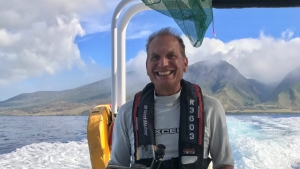Popular television series, Nature, a PBS show known for its striking wildlife documentaries, debuted a new episode, Sharks of Hawaiʻi, on April 21. Although the focus of the show was the ocean’s most vicious predator, TV producers reached out to University of Hawaiʻi at Hilo marine mammal scientist Adam Pack for guidance on humpback whales.
“Typically when we have seen tiger sharks in the presence of the humpbacks it is when a whale is already visibly ill and/or injured,” Pack explained. “That said, some calves appear to have injuries consistent with predation from sharks, usually cookie cutter sharks. This may explain in part why mothers sequester themselves with their newborns into shallow water, to avoid both natural predators as well as harassment from male humpbacks prospecting for mating opportunities.”

Pack has spent more than 25 years studying humpback whales in Hawaiʻi. Although the UH Hilo professor was not featured in the TV episode, footage of whales seen in the award-winning series was filmed while the camera crew hitched a ride with Pack in waters off Maui in 2020. Producers did however feature the veteran animal behaviorist in Nature’s exclusive online series. An in-depth interview and stunning cinematography of how Pack cautiously obtains samples from humpbacks is highlighted during the series’ behind-the-scenes feature.
“It shows my efforts to gather data on whale size and behavior using underwater videogrammetry, whale identification through surface photography, and whale hormone levels and health measures using biopsy sampling,” Pack said.
Pack’s colleagues from the Pacific Whale Foundation, Jens Currie and Stephanie Stack, are also shown operating a drone to log data on the body condition of the mesmerizing giants of the sea. All of the work occurred under National Oceanic and Atmospheric Administration federal permits.
The television episode is also available online and will stream until May 19, 2021.
For more go to UH Hilo Stories.
—By Susan Enright, a public information specialist for the Office of the Chancellor and editor of UH Hilo Stories. She received her bachelor of arts in English and certificate in women’s studies from UH Hilo.

